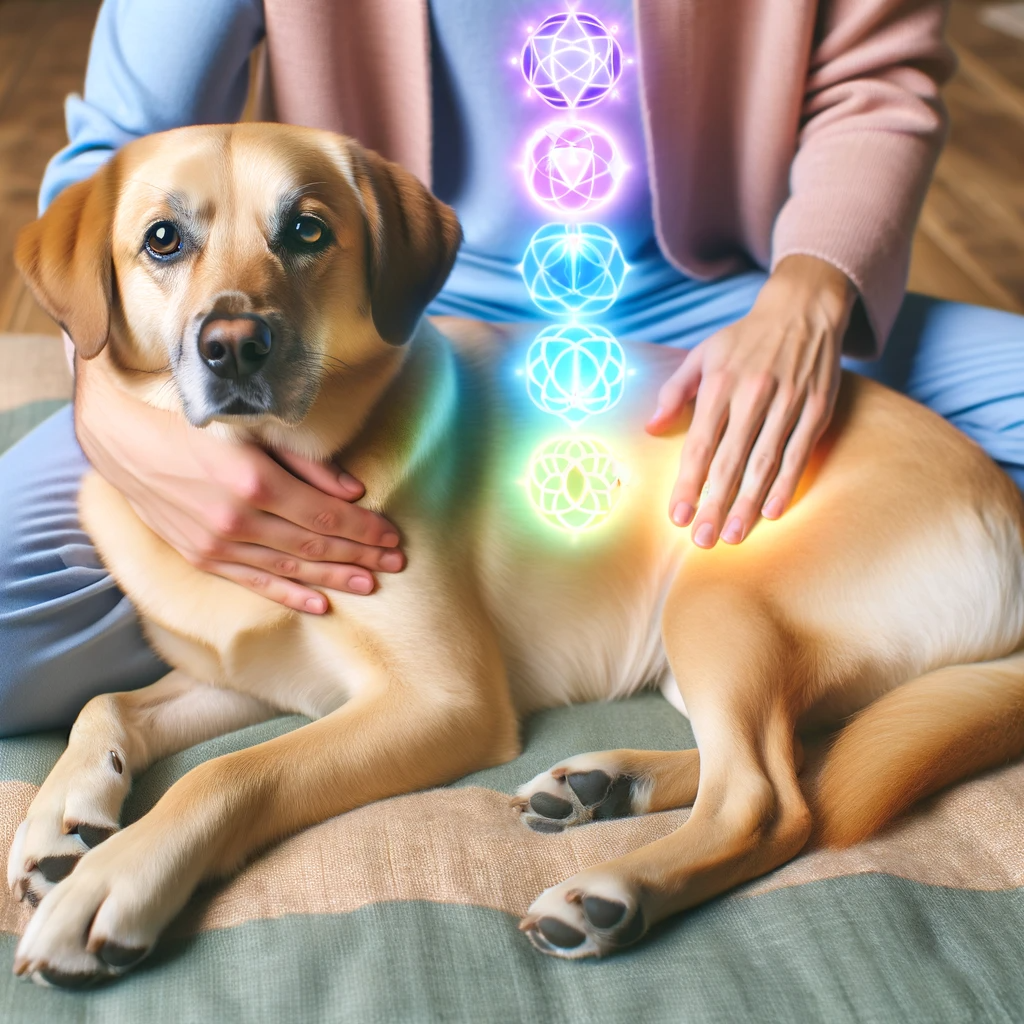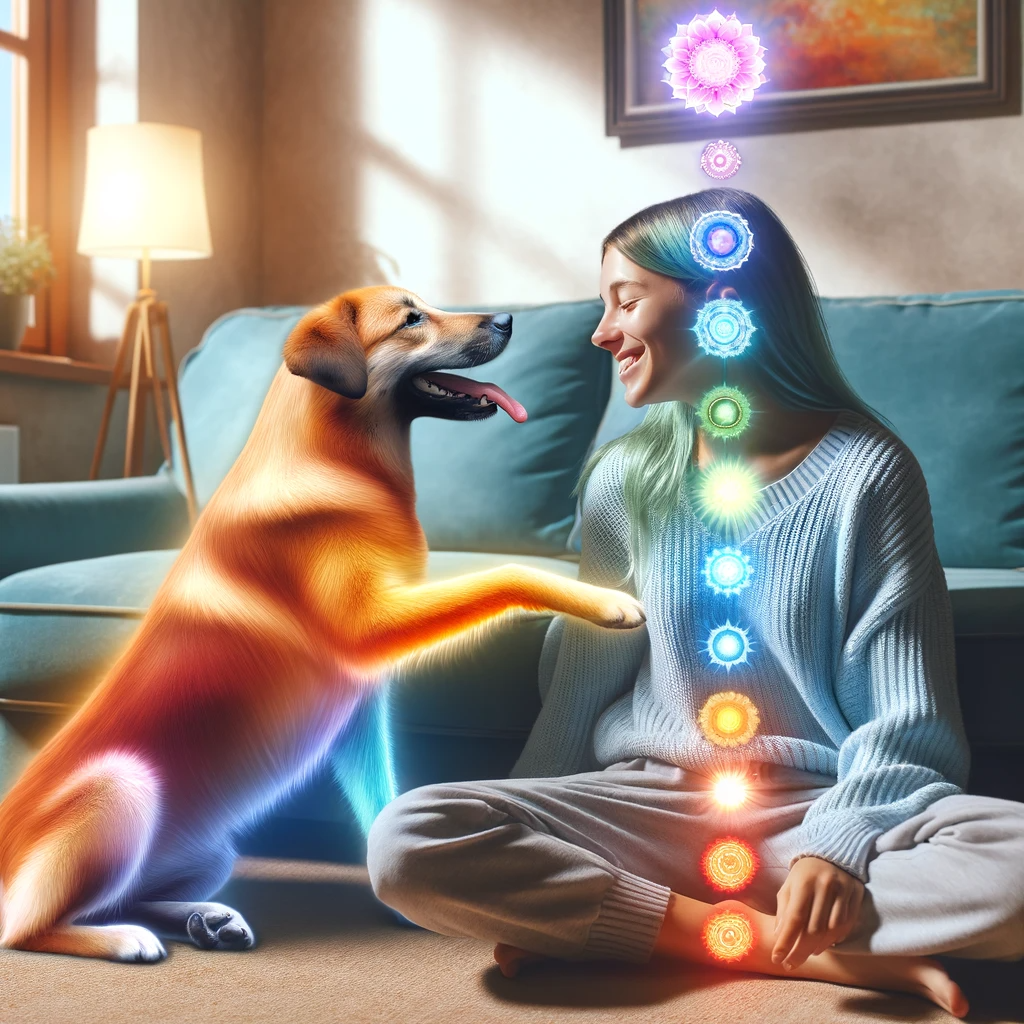Chakras refer to the energy centers in the body that correspond to specific physical, emotional, and spiritual aspects. Just like humans, dogs have chakras too. Keeping your dog’s chakras balanced is important for their overall health and wellbeing. An imbalance in any chakra can manifest in physical, behavioral, or emotional issues.

What are Dog Chakras?
There are seven main chakras located throughout the body along the spine. Each chakra correlates to certain organs, glands, and aspects of the dog’s life. The seven chakras are:
Root Chakra
The root chakra is located at the base of the spine. It represents security, survival, and feeling grounded. An balanced root chakra allows a dog to feel safe and secure. An imbalance manifests as anxiety, fearfulness, or difficulty adjusting to new environments.
Sacral Chakra
The sacral chakra is below the navel. It represents pleasure, sexuality, and creativity. A balanced sacral chakra allows a dog to experience joy in life. An imbalance can show up as lack of interest in playing or mating, or obsessive behaviors.
Solar Plexus Chakra
The solar plexus chakra is located at the sternum. It represents confidence, self-esteem, and sense of self. A balanced solar plexus chakra allows a dog to be comfortable asserting themselves. An imbalance can cause lack of confidence or excessive aggression.
Heart Chakra
The heart chakra is located near the center of the chest. It represents love, relationships, and connection to others. A balanced heart chakra allows a dog to deeply connect with their human and other animals. An imbalance can manifest as anti-social behavior, hostility, or clinginess.
Throat Chakra
The throat chakra is located at the throat and neck. It represents communication and self-expression. A balanced throat chakra allows a dog to comfortably express their needs. An imbalance can show up as excessive barking or whining.
Third Eye Chakra
The third eye chakra is located between the eyes. It represents intuition, insight, and perception. A balanced third eye chakra allows a dog to pick up on subtle cues from their environment. An imbalance can cause anxiety, reactiveness, or obliviousness.
Crown Chakra
The crown chakra is located at the top of the head. It represents spiritual connection and awareness. A balanced crown chakra allows a dog to be open to heights of consciousness. An imbalance can manifest as feeling disconnected or aimless.

Signs of Chakra Imbalances in Dogs
Some signs that your dog may have an imbalanced chakra include:
- Excessive fearfulness or anxiety
- Aggression or anti-social behavior
- Excessive barking or whining
- Lethargy or lack of interest in normal activities
- Physical issues like digestive problems or injuries
- Difficulty learning or concentrating
- Obsessive behaviors like tail chasing
- Disconnection from their human family members
If your dog is displaying any unusual behaviors, it may indicate an imbalance in one of their chakras. Pay attention to when the behavior started to help identify the affected chakra.

How to Balance Your Dog’s Chakras
Balancing your dog’s chakras involves energy healing, lifestyle changes, and promoting emotional wellbeing. Here are some tips:
Color therapy – Use the color associated with each chakra in your dog’s environment. For example, place a red blanket in their bed for the root chakra or get them a purple collar for the third eye chakra.
Chakra stones – Place stones like red jasper or citrine near your dog to help align the chakras. You can also gently place stones on your dog’s body while they are relaxing.
Flower essences – Certain flower essences can balance energies and restore harmony to the chakras. For example, calendula for the solar plexus chakra. Add a few drops to your dog’s water or directly in their mouth.
Nutrition – Make sure your dog’s diet includes nutrients to support all the chakras. For the heart chakra focus on ingredients like salmon, flaxseed, or turmeric. For the throat chakra serve Kawakawa.
Exercise – Regular exercise helps align the lower chakras by releasing pent-up energy. Walks and play also stimulate the heart chakra by deepening your bond.
Massage – Use gentle circular motions on each chakra location, especially areas that seem tense or tender. This helps open up blocked energy flows.
Meditation – Sitting calmly with your dog, gently stroking them, and focusing on their breathing is soothing for both of you. Use visualization to send them healing energy.
Nature exposure – Being outdoors helps align your dog’s upper chakras by exposing them to bright sunlight, fresh air, and grounding earth energies. Practice walking mindfully together.
Training – Teaching new tricks stimulates your dog’s solar plexus chakra by building their confidence. Use positive reinforcement to encourage self-expression.
Keeping your dog’s chakras balanced takes some awareness and intention, but has major benefits to their happiness and health. Pay attention to their needs, especially after major life changes or stressful events. With gentle care, you can help your dog align their energies and live their best life.

FAQ About Dog Chakras
How do I know which of my dog’s chakras needs balancing?
Look for signs like changes in behavior, energy level, appetite, or physical problems. Also notice when these changes arose as that can correspond to a specific chakra. For example, lethargy and disconnection after a move suggests their root chakra needs support.
How often should I check my dog’s chakra energies?
Get in the habit of checking your dog’s chakras at least once per week when you are petting or grooming them. Also check immediately after major events like a move, new pet, or trip to the vet.
Is it safe to use stones, flowers, or essential oils on my dog?
Consult your vet before using any supplements or aromatherapy on your dog. Most stones are safe placed lightly on the body, but supervise your dog to prevent swallowing. Only use a few drops of mild flower essences specifically formulated for dogs.
Can I balance my own chakras at the same time as my dog?
Yes, meditating together with your dog is mutually calming and aligning. Use the time to send loving energy to their chakras that need extra support. However, your dog may prefer more active energy healing like a walk or play session.
How long does it take to see improvements after chakra balancing?
Effects can be immediate, but allow a few weeks for the energies to fully realign. Continue to check your dog’s chakras regularly and repeat balancing techniques until their behavior and mood consistently improve. Be patient – chakras align gradually with regular care.
Balancing your dog’s chakras provides multidimensional benefits to their health and happiness. By tuning into their energetic system, you can address problems holistically and help both of you connect on a spiritual level. Pay attention to your dog’s needs and use gentle healing options for optimal wellbeing.
